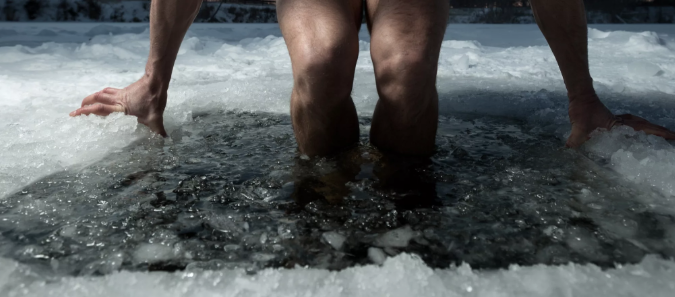When it comes to enhancing health and performance, we often think of factors like diet, exercise, and sleep. However, there’s an emerging trend in the world of fitness and wellness that’s gaining attention: deliberate heat and cold exposure. These practices, collectively known as thermal therapy, involve subjecting the body to extreme temperatures, either through heat-based methods like saunas, hot baths, or hot yoga, or cold-based techniques like ice baths, cold showers, or cryotherapy. This growing interest in thermal therapy can be attributed to the emerging evidence supporting its effectiveness for improving physical and mental well-being. In this article, we’ll explore the science behind heat and cold exposure and optimal methods for including thermal therapy in your fitness routine.
The Science Behind Heat and Cold Exposure
Heat Exposure
When it comes to heat exposure, the body responds dynamically. When exposed to heat, blood vessels near the skin’s surface dilate—a process called vasodilation. This response enhances circulation, facilitating the efficient delivery of oxygen and nutrients to muscles and organs. Simultaneously, the body engages its natural cooling mechanism by inducing sweating. Sweating aids in temperature regulation, allowing the body to dissipate heat and maintain an optimal internal environment.
Moreover, heat exposure prompts the production of heat shock proteins. These proteins play a vital role in cellular repair and stress tolerance, and there is growing evidence suggesting a potential link to increased longevity. Beyond the cellular level, the release of endorphins during activities like sauna sessions contributes to feelings of relaxation and stress reduction.
Cold Exposure
On the other side of the spectrum lies cold exposure. When faced with cold, blood vessels undergo vasoconstriction—a narrowing process that conserves heat and enables more efficient blood flow regulation. Cold exposure also activates brown adipose tissue, commonly known as brown fat. This type of fat burns calories to generate heat, potentially aiding in weight management.
The anti-inflammatory effects of cold exposure are particularly noteworthy. Techniques such as cold water immersion or ice baths have been shown to reduce muscle soreness and inflammation, making them popular choices for post-exercise recovery, especially among athletes. Cold exposure doesn’t merely impact the physical body; it also influences hormonal responses. Exposure to cold has been associated with a reduction in stress hormones like cortisol, contributing to an overall decrease in stress and anxiety. Additionally, cold exposure can modulate the immune system by increasing the production of specific immune cells, potentially enhancing the body’s defence against infections.
Benefits of Heat and Cold Exposure
Heat
- Enhanced Cardiovascular Health: Regular use of saunas or heat exposure can improve cardiovascular function. It increases heart rate and decreases blood pressure, which can improve endurance and lower the risk of heart disease.
- Improved Muscle Recovery: Heat exposure promotes blood flow to muscles, delivering nutrients and removing waste products. This accelerates muscle recovery, reducing soreness and improving overall performance.
- Stress Reduction: Heat exposure triggers the release of endorphins, the body’s natural painkillers and mood enhancers. This can help reduce stress, anxiety, and symptoms of depression.
- Enhanced Metabolism: Heat exposure can increase your metabolism, leading to potential weight management benefits. As your body works to regulate its temperature, it burns calories, contributing to weight loss or weight maintenance.
- Heat Shock Proteins: Exposure to heat stimulates the production of heat shock proteins, which play a role in cellular repair and stress tolerance. This can contribute to overall cellular health and resilience.
Cold
- Anti-Inflammatory Effects: Cold exposure, such as cold water immersion or ice baths, has potent anti-inflammatory properties. It can reduce muscle soreness, inflammation, and swelling, making it a valuable recovery tool for athletes.
- Brown Fat Activation: Cold exposure activates brown adipose tissue (brown fat), which burns calories to generate heat. This can contribute to weight management by increasing the resting metabolic rate.
- Improved Circulation and Vasoconstriction: Cold exposure leads to vasoconstriction, the narrowing of blood vessels, followed by vasodilation. This process enhances blood flow regulation, potentially improving overall circulation.
- Stress Hormone Reduction: Exposure to cold has been associated with a reduction in stress hormones, such as cortisol. This can lead to decreased stress levels, contributing to better mental and physical well-being.
- Enhanced Immune System: Cold exposure can stimulate the immune system by increasing the production of certain immune cells. This immune system modulation may enhance the body’s ability to defend against infections.
- Mental Resilience: Cold exposure, similar to heat exposure, can contribute to mental resilience. Overcoming the discomfort and stress of cold environments can help individuals build mental toughness and adaptability which can lead to better athletic performance.
How to Include Heat and Cold Therapy In Your Routine
Heat
Sauna Sessions
Start with short sessions of no more than 15 minutes at a moderate temperature (around 160-180°F or 70-80°C). As your body adapts, you can gradually start to increase the duration of your sauna sessions, or you can experiment with slightly higher temperatures for shorter durations. Current evidence suggests that for the minimum effective dose, you should aim for 57 minutes of heat exposure in a sauna per week spread over 3-4 sessions. Ensure you drink water before and after your sauna session to stay hydrated.
Hot Baths/Showers
Begin with a comfortable temperature and gradually increase as your body adjusts. To experience the muscle-relaxing and calming effects, spend 15-20 minutes in a bath at a temperature of 95-105°F or 32-40°C.
Hot Yoga
Participate in hot yoga classes where the room is typically heated to around 95-105°F (35-40°C). Regular practice can enhance flexibility and promote mental relaxation.
Cold
Cold Showers
Ease into cold exposure by starting with cool water and gradually decreasing the temperature. Focus on allowing cold water to flow over your arms and legs for enhanced circulation. As your body adapts, start to gradually increase the exposure to the cold.
Ice Baths
Consider taking an ice bath following a conditioning/endurance workout to reap the recovery benefits. Start with a duration of 1-5 minutes per session at a water temperature of 10-15°C (50-59°F), and as your body adapts you can experiment with lower temperatures and different durations – the colder the temperature the shorter the amount of time you need to expose yourself to the cold. You only need to perform deliberate cold exposure for a total of 11 minutes per week according to recent evidence. This should be divided into 2-4 sessions lasting 1-5 minutes.
Cryotherapy
Cryotherapy can be delivered through various methods, including whole-body cryotherapy, localised cryotherapy, and cryo chambers. If you’re new to cryotherapy, start with shorter sessions and gradually increase the duration as your body adapts. Professional cryotherapy centres often have trained staff to guide you through the process, with sessions typically lasting 2-4 minutes. Consider incorporating cryotherapy after strenuous workouts or physical activities, however it can be used as needed for specific areas of discomfort. Athletes may use it more frequently during intense training periods, while others may incorporate it on a weekly or bi-weekly basis.
Dos and Don’ts of Hot and Cold Therapy
Do:
- Use the sauna if you want to improve your endurance.
- Experiment with hot water immersion prior to a workout – this may improve neuromuscular function and potentially lead to better performance.
- Incorporate cold therapy if you hate it – these people get the most benefit.
- Expose yourself to cold therapy for at least 11 minutes per week.
- Put your face in when using an ice bath – this will lower your heart rate and increase your tolerance for stress.
- Use cold therapy after an endurance workout.
Don’t:
- Rely too heavily on heat/cold therapy for your recovery – a good diet, sufficient quality sleep, and rehydration should always be prioritised over other recovery methods.
- Use heat therapy if you are dehydrated.
- Use cold therapy for at least 4 hours after a strength/hypertrophy session – this may interfere with strength and muscle gains.
- Sit still when in an ice bath – moving your limbs will increase your pain threshold.
- Jump into the deep end too quickly – with both heat and cold exposure, begin with manageable temperatures and durations and gradually build up the intensity over time as your body adapts.
References
Peake, J.M., Markworth, J.F., Cumming, K.T., Aas, S.N., Roberts, L.A., Raastad, T., Cameron-Smith, D. and Figueiredo, V.C., 2020. The effects of cold water immersion and active recovery on molecular factors that regulate growth and remodeling of skeletal muscle after resistance exercise. Frontiers in Physiology, 11, p.737.
Kim, K., Monroe, J.C., Gavin, T.P. and Roseguini, B.T., 2020. Skeletal muscle adaptations to heat therapy. Journal of Applied Physiology, 128(6), pp.1635-1642.
Moore, E., Fuller, J.T., Buckley, J.D., Saunders, S., Halson, S.L., Broatch, J.R. and Bellenger, C.R., 2022. Impact of cold-water immersion compared with passive recovery following a single bout of strenuous exercise on athletic performance in physically active participants: a systematic review with meta-analysis and meta-regression. Sports Medicine, 52(7), pp.1667-1688.
Brunt, V.E. and Minson, C.T., 2021. Heat therapy: mechanistic underpinnings and applications to cardiovascular health. Journal of Applied Physiology.





